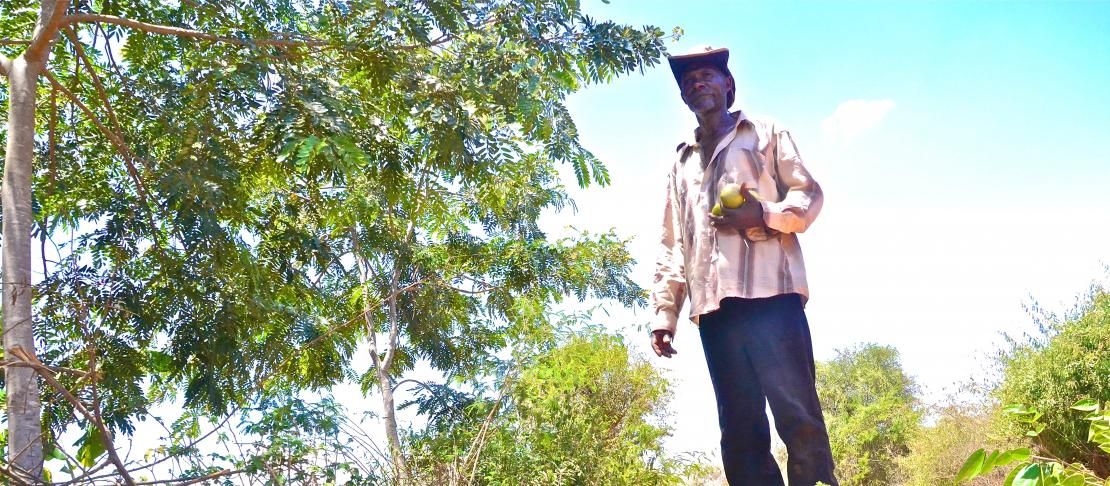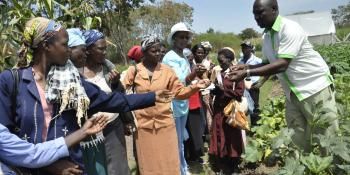Farmers use soil and water management practices to respond to changing rainfall patterns

Investment in appropriate and affordable rainwater harvesting and soil conservation measures are crucial to address crop and livestock production constraints in drylands.
In semi-arid eastern Kenya, farmers Peter and Ruth Nguli continue to witness an increasingly dry and heating climate. The pair hails from Wote, in Makueni County and practice mixed farming. Wote is one of CCAFS Climate-Smart Villages (CSV) where farmers, scientists and extension officers are trialing a selection of climate-smart practices to see which ones work best in the midst of prevailing changes. Peter and Ruth are also participating in the CSV activities.
A village household survey conducted in Wote showed average farm sizes comprise three to four acres. Crops cultivated included maize, cowpeas, pigeon peas, green grams, mangoes, citrus and pawpaw. This is despite high incidences of crop failure — for every ten years, crops fail eight times due to inadequate rainfall. Goats and cattle are the livestock commonly reared in Wote.
Farmers in semi-arid areas such as Wote are embracing practices that enhance agricultural productivity. For instance, Peter and Ruth have turned to soil conservation. They use manure and inorganic fertilizers and improved rainwater harvesting techniques to ensure the soil is kept moist and fertile. A new study, by researchers from the CGIAR Research Program on Climate Change, Agriculture and Food Security (CCAFS) and Jomo Kenyatta University of Agriculture and Technology (JKUAT), sought to identify water management technologies and practices that could help farmers adapt to climate change within drylands. These included water management practices for soil moisture replenishment, and water harvesting using storage structures.
The findings of this study are documented in a journal article, titled 'Changing rainfall patterns and farmers’ adaptation through soil water management practices in semi-arid eastern Kenya.'
Changing rainfall patterns
This study has shown that average annual rainfall amounts have been gradually decreasing for the past 50 years for Makueni and the neighboring Machakos counties. In Makueni, the long-term rainfall trends reveal a slight decline in rainfall and number of rainy days for both March-April-May (MAM) and October-November-December (OND) seasons. In Machakos, the long-term rainfall trends reveal a slight decline in the rainfall amounts in the OND season and in the number of rainy days for the MAM season. The decline in rainfall amounts means natural rainfall on its own cannot sustain crop and livestock production. The reduced rainy days also indicate longer dry spells with negative impacts on crop survival.
In the study, seasonal water budgets were computed for crop and livestock production which could be realized through water management practices for soil moisture replenishment and water harvesting. The first set of practices for soil moisture replenishment (referred to as green water) included cut-off drains or diversion ditches, artificial waterways, retention ditches, bench terraces, reverse slope bench terraces, terraces with soil thrown upslope, channel terraces, grass strips, trash lines, road runoff, planting pits, presence of agroforestry and tree planting, woodlots, trees on boundary, and irrigation. The second set of practices on water harvesting using storage structures (referred to as blue water) included roof catchment into a surface tank, communal water pans and earth dams.

Water retention ditches on Peter and Ruth Nguli's farm. Photo: C.Schubert (CCAFS).
Policy recommendations
This study has three policy recommendations. First, the seasonal rainfall provides an opportunity for investment in appropriate and affordable rainwater harvesting technologies that can be scaled up in similar areas to address crop and livestock production constraints. Second, the local community in conjunction with the county governments and Ministry of Agriculture need to develop water harvesting and utilization by-laws for increased water use efficiency. Finally, there is need for provision and integration of improved climate information and prediction products to farmers for on-farm decision making.
Download the paper:
Recha JW, Mati BM, Nyasimi M, Kimeli P, Kinyangi JM, Radeny M. 2016. Changing rainfall patterns and farmers adaptation through soil water management practices in semi-arid eastern Kenya. Arid Land Research and Management 1-10.
John Recha is a Post Doctoral Fellow - Participatory Action Research, Phillip Kimeli is a Research Assistant, Vivian Atakos is a Communications Specialist. They all work for CCAFS East Africa.




